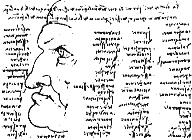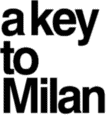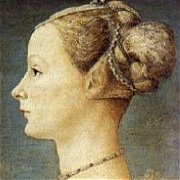




























|
|
|
Private Art Collections
Some of the many private art collections
established throughout the centuries in Milan still preserve their
'private' character, although they do have a profound social role
and are usually open to the public.
The most outstanding among these - and the first great Milanese
cultural institution of its kind - is the

|
|


|
|
Ambrosiana
The narrow Via Cardinal Federico on the
left side of the Ambrosiana building recalls the name of the Cardinal
and Archbishop of Milan, a member of the Borromeo family,
who in 1609 arranged here - in this building, constructed ad hoc
to projects by Fabio Mangone and Ricchino - a grandiose collection
of ancient manuscripts, parchments and books. He had himself commissioned
their collection throughout Europe and the Middle East.
The aim of this research institute was
to defend Catholic orthodoxy in a time of threatening polemic
with Protestantism. The manuscripts collected in the Biblioteca
Ambrosiana (Ambrosiana Library) were intended to contribute
to studies to establish the only official version of the Bible.
This was in purposeful opposition to Martin Luther's German translation
of the Bible and, especially, to his theory which favored the
free interpretation of the sacred texts.
A few years later, Cardinal Federico added an Academy of art
studies to the Library, donating to it his personal collection
of paintings, and thus founded the Pinacoteca Ambrosiana
(Ambrosiana Gallery).
Since then the initial combativeness in ideological matters has
obviously mellowed considerably, while the collections have steadily
grown in scope and size. Today the Ambrosiana is a private and
autonomous ecclesiastical foundation, directed by four scholars
and by a Prefetto (curator-in-chief). Its atmosphere is
a peculiar mix formed, on the one hand, by awareness of being
one of the most prestigious cultural institutions in the world
and, on the other, by an air of familiarity typical of certain
old Milanese institutions.
On entering the building, a door beside
the custodian's desk leads into the luminous reading room of the
BIBLIOTECA AMBROSIANA - until 1922 this room was the main
courtyard of the building.
In the dark rooms around are preserved
books and very old prints, often extremely rare, and over 30,000
manuscripts, among which treasures of Hebrew culture and Oriental
and European Bibles as well as some of the first illustrated manuscripts,
going back to the 3rd century AD. There are also drawings
by the Old Masters, and the Codex Atlanticus, over
one thousand pages of drawings by Leonardo.
Consultation of many of these texts is strictly for researchers,
but facsimile reproductions are available.
Although this boundless cultural wealth of the Biblioteca Ambrosiana
has not all been reexamined with the latest methods in recent
time, reference can be made to numerous critical works elaborated
by academics the world over.
The PINACOTECA AMBROSIANA is more
readily available to non-professionals. It is apparent that Cardinal
Federico favored 16th century Venetian painters as well as his
own Lombard contemporaries, and that he had a predilection for
Dutch culture. Subsequent donations have, nevertheless, broadened
the Pinacoteca's scope.
We will list some of the greatest artists
whose work is among the collections here. Tuscan Renaissance:
Botticelli, Ghirlandaio, Leonardo da Vinci (The Musician);
Lombard and Venetian Renaissance: Bartolomeo Vivarini,
Bergognone, Luini, Bramantino, Leonardo's school. Besides Raphael's
enormous cartoon for his School of Athens in the Vatican,
the gallery has works by Magnasco, Tiepolo, Caravaggio
(Basket of Fruit), Barocci, Moretto, Tiziano, Bassano,
and the typical 17th century Lombard painters Tanzio da
Varallo, Cerano, Daniele Crespi. The main Dutch works of this
collection are by the primitive Geertgen tot Sint Jans (Virgin
and Child), and by Jan Brueghel, who was a personal
friend of Cardinal Federico: this series of small paintings by
Brueghel is one of the gallery's true gems.
|
|
Piazza Pio XI 2
 |
Duomo or Cordusio
|
reopened after restoration
on October 21, 1997
10AM - 5:30PM
• closed Monday and on public holidays
entrance charge
tel. 02 806921
|
The other great 17th century Milanese
art collection is that of Cardinal Monti. It can be seen
only by scholars with references, because it has been property
of the Arcivescovado since 1650.
Another excellent example of a completely different type of Milanese
private collection is instead open to the public:

|
|
|
|
Museo Poldi Pezzoli
Gian Giacomo Poldi Pezzoli, the founder
of this illustrious museum-home (which is one of the most
prestigious in the world) was, on the maternal side, a Trivulzio,
one of Milan's oldest, most cultivated and most endowed families.
In his frequent travels in Italy and abroad, his knowledge of
the arts was enhanced and he purchased numerous art works - his
acquisitions reveal his particular taste for Italian paintings
from the Renaissance to the 18th century. He also became
very interested in applied arts such as arms, porcelains,
tapestries, jewelry and antiques. The Poldi Pezzoli collection
was gradually gathered together in the building which still houses
it today.
Gian Giacomo Poldi Pezzoli arranged his
home in a way which would show his sophisticated collection to
full advantage, giving each chamber a different color tone and
style designed to suit the art works exhibited therein. After
Poldi Pezzoli's death (1879), his museum-home became a foundation
- as he had willed - and has been open to the public since 1881.
To offset the damages caused by the bombardments during World
War Two, the building was rebuilt to reproduce as faithfully as
possible its original style and ambience, although the rooms were
adapted to the necessities of a larger public.
The Poldi Pezzoli Foundation is
attentive to the problems of artistic preservation, to the accuracy
of its exhibitions and to the educational function of art. It
publishes books and has a comprehensive catalogue of its collections.
It also organizes regular temporary exhibitions.
The Portrait of a Young Woman,
a 15th century masterpiece by the Tuscan painter Piero del Pollaiolo,
has become the symbol of the museum. It truly is one of the most
exciting works in the exhibition, but it is by no means the only
one. On the ground floor a collection of arms of outstanding
rarity is exhibited, and the 'Sala dell'Affresco' is named after
a ceiling fresco which was brought here from a Lombard villa;
it is only on reaching the first floor however - the fountain
by the staircase was built in the 19th century in Baroque style
- that you get into the very heart of the collections.
Here are paintings by masters of the Lombard Renaissance:
Foppa, Zenale, Luini, Solario, Cesare da Sesto, along with the
Venetians Giovanni Bellini, Andrea Mantegna, Cima da Conegliano,
Lorenzo Lotto, and the Central Italians Pollaiolo, Piero
della Francesca, Botticelli, Perugino. There are also remarkable
artworks of the Flemish school, of some 17th & 18th
century Lombard painters such as Morazzone, Procaccini, Nuvolone,
Magnasco, Fra' Galgario, and of the Venetians Giambattista Tiepolo
and Francesco Guardi. A double portrait of Luther and his wife
comes from the studio of Lukas Cranach.
Other rooms exhibit collections of antique clocks - a gift of
the Falck family of steel magnates -, sundials - a gift
of the Portaluppi family -, small bronze sculptures - belonging
to the Crespi family -, Murano glass, jewels and
lacework. The extreme heterogeneity of these collections
allows unusual juxtapositions and comparisons, and makes a visit
to the museum full of surprises. One of these is a small processional
cross, considered of late to be the work of the young Raphael.
|
|
Via Manzoni 12
 |
Montenapoleone
|
10AM - 6PM
• closed Monday
entrance charge
tel. 02 794889
E-mail
website
|
A second very important private collection
of 19th century origin has recently (1995) been opened as an exhibition
not far from the Poldi Pezzoli Museum. It is the

|
|
|
|
Museo Bagatti Valsecchi
At the end of the 19th century, two rich
barons and lawyers, Fausto and Giuseppe Bagatti Valsecchi, sons
of a sketcher and miniaturist, decided to turn their home into
a neo-Mannerist-style 'palace'. They succeeded so brilliantly
that, on first impact, a non-specialist will be convinced that
he is treading the grounds of an authentic 16th century palazzo.
The tasteful blending of authentic works (collected throughout
Lombardy and elsewhere) with ornaments and decorations that are
simply remakes of the original is stretched to its limit.
You will thus find original tapestries set in mock-antique fabric
surrounds and original panels in 'false' frames. The Bagatti Valsecchi
home is a fascinating document of Milanese 19th century artistic
taste, as well as of 16th century Lombard art.
The transformation of the Bagatti Valsecchi
home into a foundation is quite recent, because the family occupied
this house until just a few years ago.
Besides some masterpieces by Northern-Italian Renaissance
painters Giovanni Bellini, Zenale and Gianpietrino, there are
many rare antiques such as a carved bed from Valtellina
and an extremely rare folding chair of the 15th century. There
are also a very unusual seat decorated with woodcuts, and some
adorable remakes such as a shower decorated to look like a Renaissance
drinking-trough, and a wrought iron basin with running water.
The cultural activity of well-to-do
Milan is concentrated chiefly around these private museums.
The Museo Bagatti Valsecchi organizes various activities
connected with gracious living in late 19th century homes (specialized
courses on the applied arts, visits to private homes with interiors
and furnishings of particular interest, seminars on aspects of
19th century culture). All the relative information can be obtained
from the museum.
The Friends of the Poldi Pezzoli Museum Association - which
runs cultural courses, guided visits, excursions and study tours
- has its own premises, though adjoining the museum (Via Morone
8, 3 -6 PM, closed Saturday and Sunday, tel. 02 780872);
new members have to be presented by an existing member.
|
|
Via Gesù 5
 |
Montenapoleone
|
1 - 5:45PM
• closed Monday and on public holidays
entrance charge
tel. 02 76006132
E-mail
website |
|
All rights reserved
copyright © 1996-2001
Monica Levy, Roberto Peretta
copyright © 1996-2001
Ulrico Hoepli SpA, Milano

[Want to purchase
the guidebook ?]
[Instructions on how
to do it]
|
|
|
|